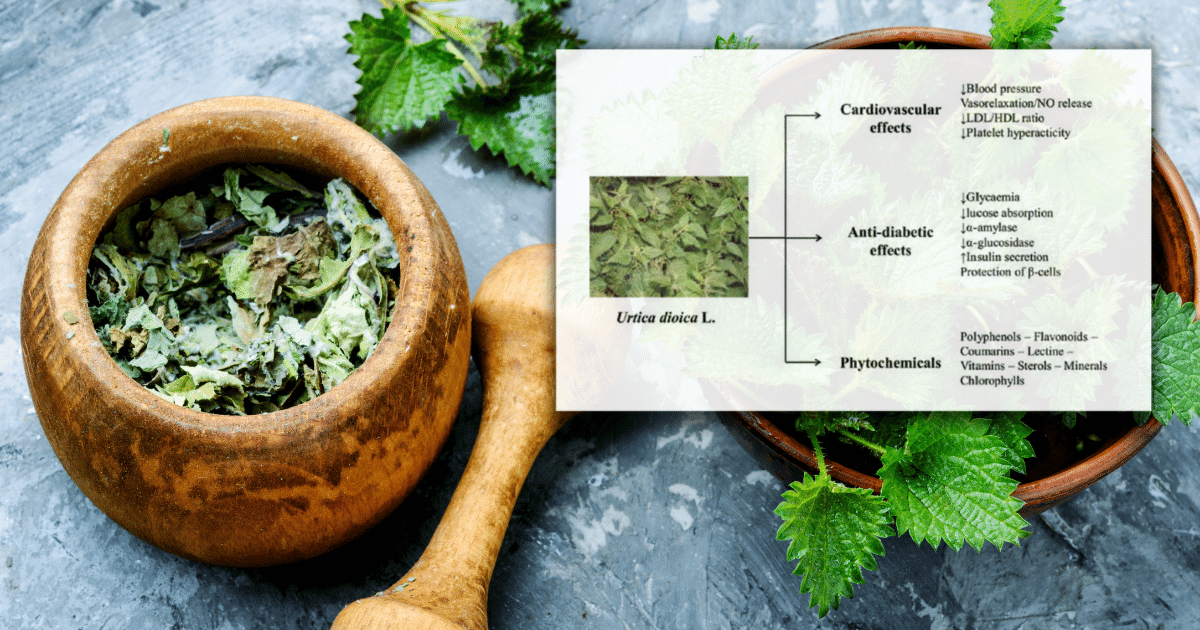Stinging nettle is a type of flowering plant, generally regarded as a weed, that is regularly discussed within the hair loss space. This is because stinging nettle offers a variety of unique compounds that appear to modulate our hormones.
People consume stinging nettle either as the whole plant extract, or generally the key compounds it contains. Whether it be the gaelic acid or the zinc-protein complexes, people choose to utilize stinging nettle for a myriad of different compounds that directly act on our hormonal centers.
Stinging Nettle – An Underrated Hair Loss Herb?
Modulating our hormones to a more favorable profile is not a new approach either. This is actually a very well established mechanism by which we can acquire some of the benefits associated with drugs like finasteride and spironolactone, for our hair.
But finasteride and spironolactone are very potent drugs that act specifically on certain sites like the 5AR enzyme or the androgen receptor. The data surrounding stinging nettle, its targets, and its effects, remains inconsistent.
People have argued that it can either help prevent hair loss or serve as a vehicle for worsening hair loss. Why? Well, hormone modulation is rarely ever one sided.
Some key questions relating to stinging nettle include:
- Does it stop aromatase activity?
- Does it increase testosterone production?
- Does it decrease DHT production?
- Does it increase estrogen signaling?
These points, and more, will be addressed in this article.
Stinging Nettle Demystified
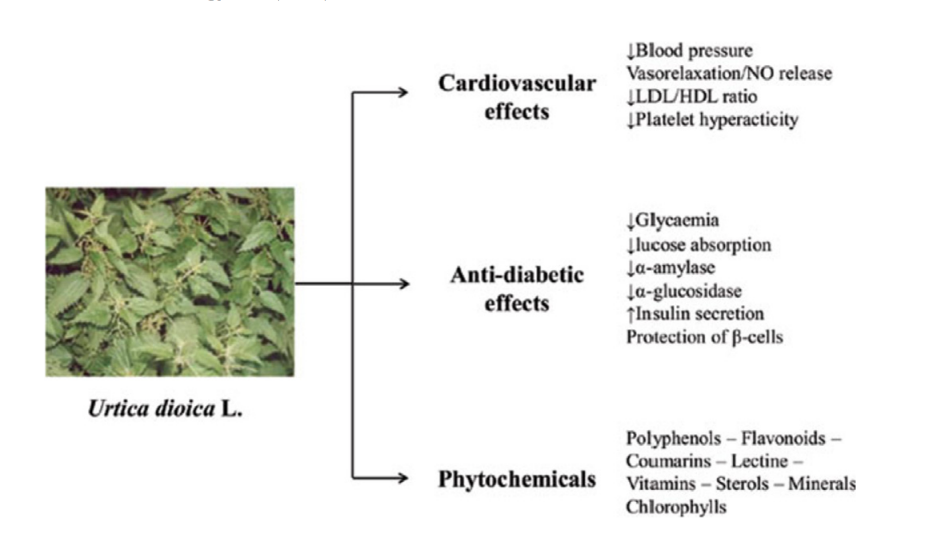
What’s In Stinging Nettle?
Stinging nettle is certainly a special plant, as evidenced by its use in replenishing over-fertilized soil with key elements and minerals. Some of these minerals present in stinging nettle are in such large amounts that it quite literally blows away most multivitamins out of the market.
For example, in about 100g of stinging nettle, there is about 50mg of chlorophyll – the pigment molecule that gives plants their characteristic green color. Chlorophyll has been shown to be a useful anti-inflammatory for hair loss.
With that high chlorophyll concentration, you also get a load of key micronutrients needed for cells to function. Stinging nettle contains high amounts of the following micronutrients:
- Zinc
- Copper
- Manganese
- Cobalt (needed for vitamin B12)
Additionally, it also contains a large amount of gallic acid, a molecule known for its uniquely beneficial effects on the cells of the hair microenvironment such as dermal papilla. Gallic acid is also usually part of many cosmetic drugs for its synergistic effects with azelaic acid, a well known hair loss compound.
The hormone modulatory effects of stinging nettle also come from the numerous phytochemicals it contains, such as:
- Secoisolariciresinol, capable of modulating the aromatase enzyme.
- Lignans, which affect SHBG.[1]https://www.thieme-connect.com/products/ejournals/abstract/10.1055/s-2006-957756
- Flavanols that are able to counteract DHT.
This pharmacological gives some credence to the use of Stinging nettle for hormonal modulation.[2]https://pubmed.ncbi.nlm.nih.gov/31163183/ But what effect does this have on hair loss?
Why Do People Believe Stinging Nettle Can Help With Hair Loss?
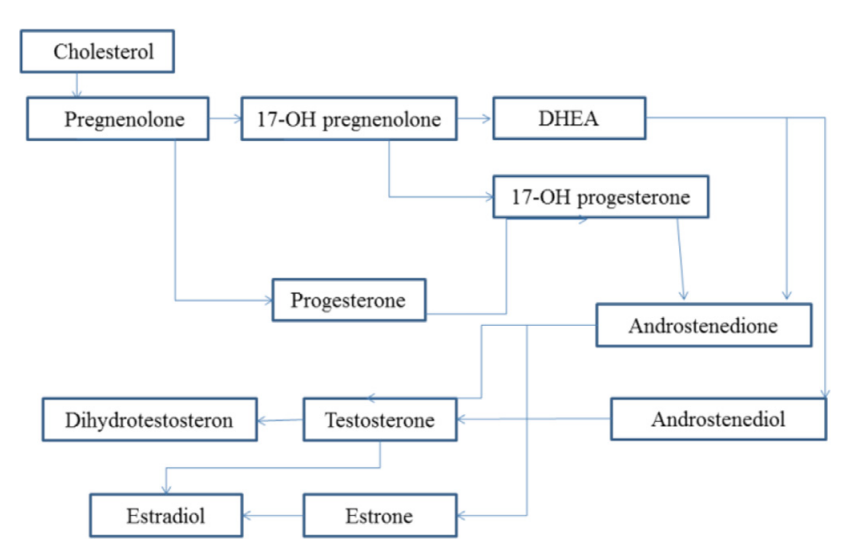
Stinging nettle may have first garnered traction as a hair loss treatment when it was used in older studies on mice with prostate hyperplasia (a disease where the prostate gland enlarges, and primarily thought of being due to the influence of DHT). In these studies, stinging nettle showed a therapeutic effect.
It was then later confirmed in clinical trials that stinging nettle indeed does beneficially reduce prostate hyperplasia. Ever since, there have been combination therapies that included stinging nettle with finasteride for reduction of prostate hyperplasia.[3]https://pubmed.ncbi.nlm.nih.gov/7509261/[4]https://pubmed.ncbi.nlm.nih.gov/15045190/[5]https://pubmed.ncbi.nlm.nih.gov/10971268/
Since stinging nettle by itself favorably reduces systemic DHT production without altering testosterone production. It has also been used in the bodybuilding world to reduce androgenic effects from hormones – such as hair loss from steroid use.
This is probably where the use of stinging nettle as a hair loss therapeutic for androgenic alopecia originated. However, that’s not all stinging nettle can do. Pharmacological evidence exists for its ability to reduce:
- Overactive immune signaling, which is present in alopecia areata.
- Excess production of prostaglandins and lipid peroxides negatively affects scalp health and are related to conditions like seborrheic dermatitis.
- Heavy metal toxicity and improve mineral deficiencies, which can lead to telogen effluvium hair loss.[6]https://pubmed.ncbi.nlm.nih.gov/31163183/
What About The Evidence On Humans and Hair Loss, Specifically?
After scouring the literature for any evidence of the use of stinging nettle in hair loss, via randomized controlled trials and reviews, no results came up.
Then, by expanding our range to include studies on the use of stinging nettle in vitro and ex vivo, still, no results were found.
Similarly, when further expanding to include mice and animal models of stinging nettle for hair loss, no experiment had been performed to date.
The Perfect Hair Health team then searched beyond the more reputed scientific journals that had investigated stinging nettle for hair loss. Here were our only findings:
- In a single-blinded clinical trial on the use of stinging nettle (but as part of a proprietary combination of ingredients within a shampoo, and herbal solution), researchers from Slovenia showed some incredible results from this formulation. The results appear almost too good to be true.[7]https://www.acta-apa.org/journals/acta-dermatovenerol-apa/papers/10.15570/actaapa.2018.13/actaapa.2018.13.pdf
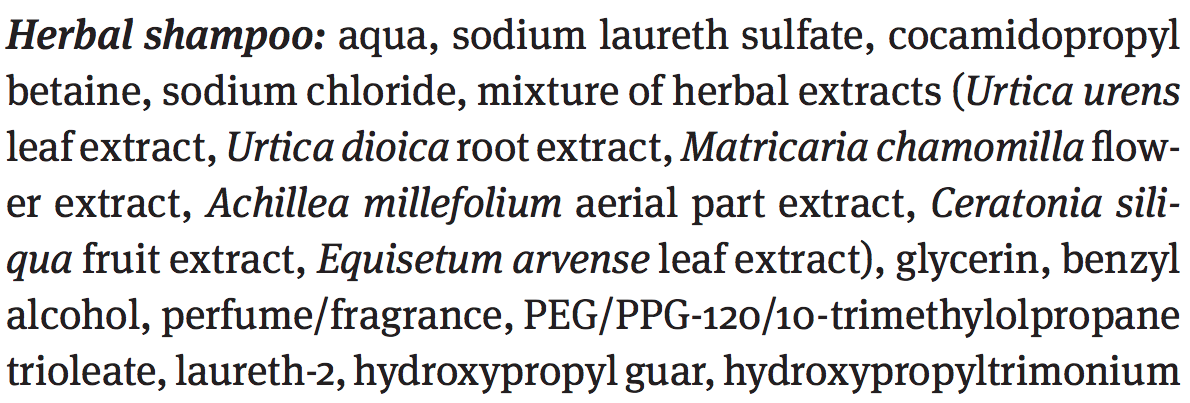
For example, when comparing the groups to each other (shampoo, shampoo + solution, vs. placebo for either shampoo or shampoo + solution), their significance threshold exceeded the requirements for statistically significant results by a factor of 100x to 1,000x. And when compared to placebo, by 10,000x.

These kinds of results are worthy of much further investigation. So why has it not been investigated until now?
First, they took qualitative values into account (like how they felt about their own hair after a couple of months) for this assessment. Which, by its nature, can drive unrealistic results. When we look at the quantitative value, we notice just a mild increase in hair count when compared to the placebo.
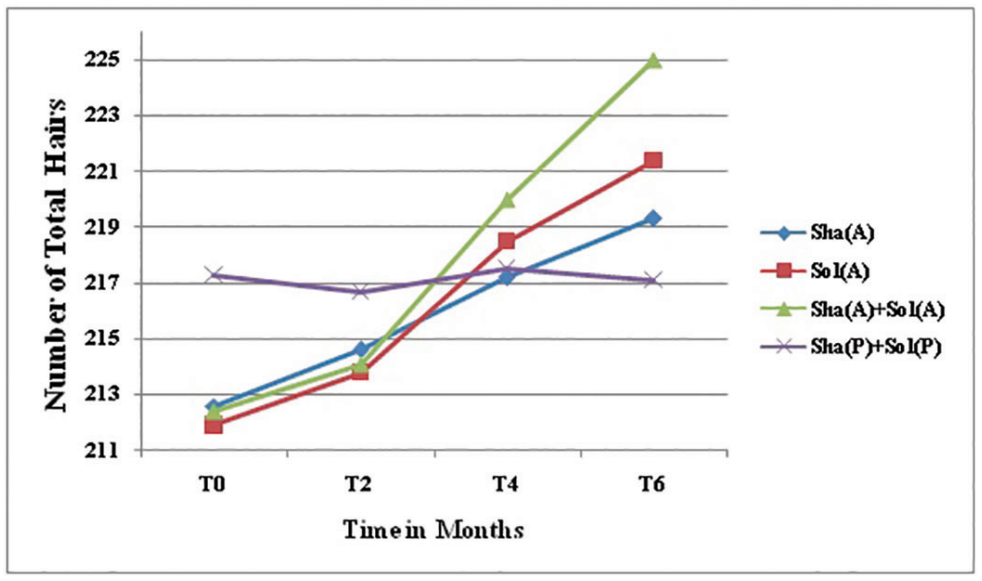
This graph shows that at the beginning of the study, the hair count for the placebo was 217. Hair counts for treatment groups were around 210-213. After six months, T6, hair count for placebo stayed the same but hair count for the best group rose to 225. That’s, at best, a 15 hair count increase.
Nonetheless, this clinical trial deserved further study and replication. However, the confounding ingredients really make it tough to ascertain if the effects were solely from stinging nettle.
Aside from this one study, there exist patents for stinging nettle as a hair loss therapeutic, containing the following additional ingredients:

Unfortunately, the only additional piece of evidence we have for stinging nettle for alopecia is its potential use in scarring alopecia and alopecia areata.[8]https://patents.google.com/patent/WO2000056269A2/en
- In this in vitro analysis, a herbal extract containing stinging nettle (but also containing Equisetum Arvense Leaf Extract, Achillea Millefolium Aerial Part Extract, Matricaria Chamomilla Flower Extract and Ceratonia Siliqua Fruit Extract), was assessed for its effects on interleukin-1α (IL-1α), a proinflammatory cytokine.[9]https://www.ncbi.nlm.nih.gov/pmc/articles/PMC6126931/
Their results showed about a 5x reduction in IL-1α signaling, reaching great significance.
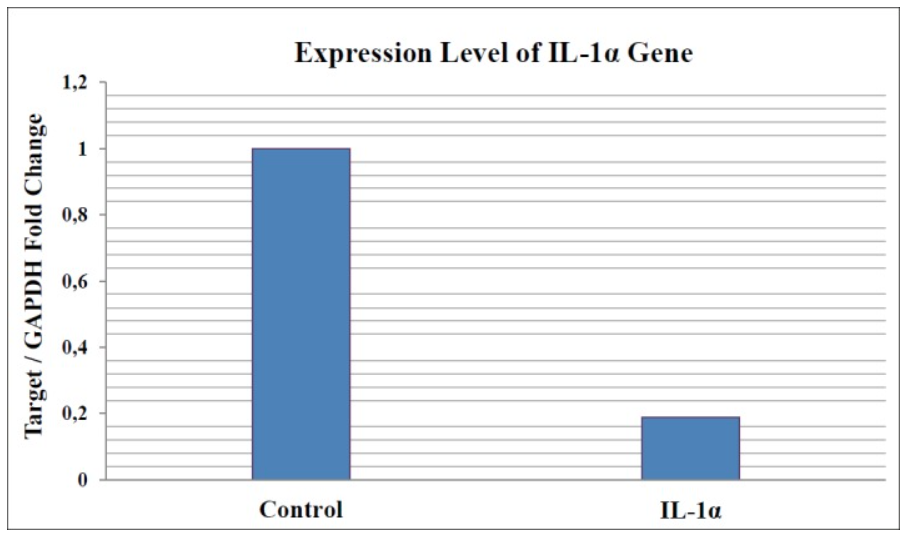
Aside from these studies on hair related mechanisms and hair loss as a whole, stinging nettle has been investigated for its effects on:
- Inhibiting aromatase, which is generally raised in androgenic alopecia and metabolic dysfunction. Aromatase is the enzyme known to be able to convert testosterone into estrogen.[10]https://pubmed.ncbi.nlm.nih.gov/17238068/
- A systematic review denoted that stinging nettle showed promising results against inflammation, but that it requires further trials to determine the true effect size.[11]https://pubmed.ncbi.nlm.nih.gov/23391017/
- As compared to placebo, stinging nettle showed benefit in reducing allergic rhinitis, a condition marked by higher histamine release, making it potentially useful against androgenic alopecia and alopecia areata.[12]https://pubmed.ncbi.nlm.nih.gov/2192379/
- A review on stinging nettle concluded it had great anti-microbial activity [13]https://pubmed.ncbi.nlm.nih.gov/35251206/
- A systematic review found that stinging nettle reduced fasting blood sugar in type two diabetics, but had no real substantial effect on fasting insulin or their HBA1C levels.[14]https://pubmed.ncbi.nlm.nih.gov/31802554/
Accessing the Data On Stinging Nettle
The wide-ranging data on stinging nettle makes it difficult to draw hard conclusions about its efficacy. With that said, stinging nettle may prove useful for general health, scalp health, and immune signaling.
Most notably, there is a lack of evidence on its use in isolation, or in combination, with other therapies to treat alopecia of any kind. Because no data exists, it would be a stretch to recommend stinging nettle for hair loss.
While it has shown effects on hormonal modulation, it can’t be assumed that stinging nettle lowers DHT and effectively treats androgenic alopecia.
Based On The Evidence
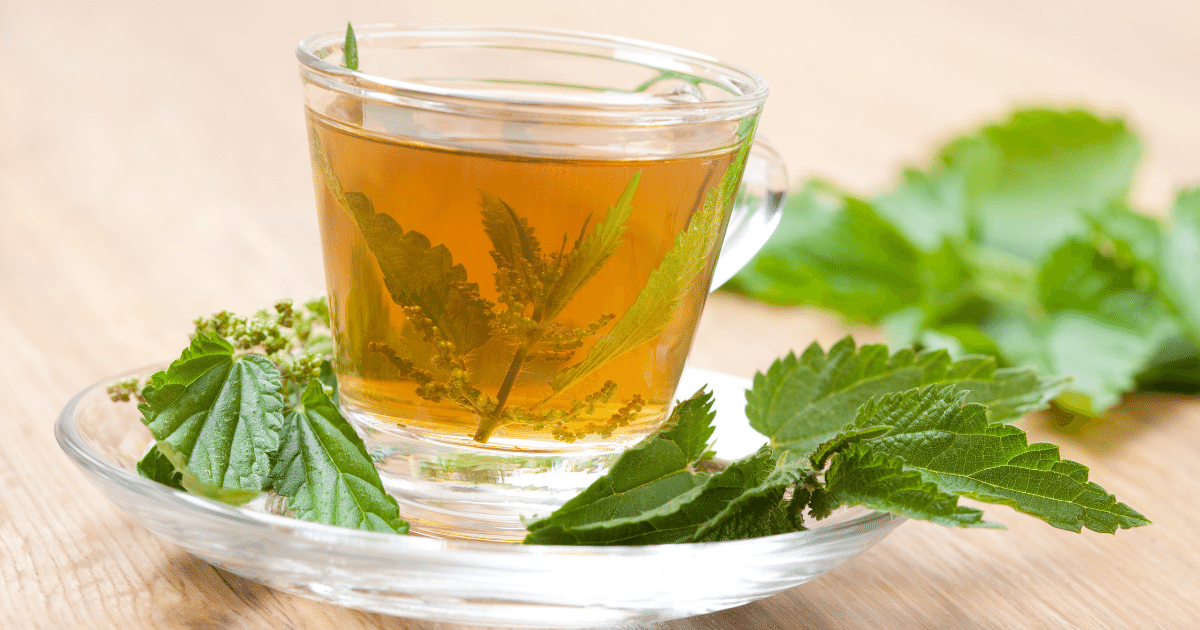
Should We Use Stinging Nettle?
When it comes to stinging nettle for general health, it can be a useful tool to have in the arsenal. It favorably modulates hormones and reduces blood sugar, which can affect our extracellular matrix and collagen. It has also been shown to prevent the rise of inflammatory molecules.
For Those Who Plan To Use It, What Is The Best Frequency and Dosage?
Most of the studies performed use stinging nettle extract. The extracts are made up of the roots, the leaves, or a whole-plant combination. The dosing ranged from as little as 200 mg to as high as 1000 mg, and typically not exceeding this amount.
Further, in vitro studies used a moderate percentage of around 10%.
Of the studies performed on humans, stinging nettle was used daily whether in conjunction with other herbs or medications.
Oral Or Topical?
We believe that oral supplementation may be the best for the general health benefits stinging nettle can provide. Topical formulations can produce some favorable effects on the scalp as well. Stinging nettle may also reduce complications present with seborrheic dermatitis and act as an antimicrobial with positive implications for androgenic alopecia.
Additional Advice?
There is a possibility that some people may actually be allergic to stinging nettle. It’s known as stinging nettle because the chemical released by its leaves can induce a rash or mild stinging sensation. Before using stinging nettle, try rubbing a bit of pure stinging nettle extract on your skin to see if you have any allergic reactions.
Watch this video to see how it can be done.
We’ll continue to update this article as research emerges.

Rob English is a researcher, medical editor, and the founder of perfecthairhealth.com. He acts as a peer reviewer for scholarly journals and has published five peer-reviewed papers on androgenic alopecia. He writes regularly about the science behind hair loss (and hair growth). Feel free to browse his long-form articles and publications throughout this site.
References
| ↑1 | https://www.thieme-connect.com/products/ejournals/abstract/10.1055/s-2006-957756 |
|---|---|
| ↑2, ↑6 | https://pubmed.ncbi.nlm.nih.gov/31163183/ |
| ↑3 | https://pubmed.ncbi.nlm.nih.gov/7509261/ |
| ↑4 | https://pubmed.ncbi.nlm.nih.gov/15045190/ |
| ↑5 | https://pubmed.ncbi.nlm.nih.gov/10971268/ |
| ↑7 | https://www.acta-apa.org/journals/acta-dermatovenerol-apa/papers/10.15570/actaapa.2018.13/actaapa.2018.13.pdf |
| ↑8 | https://patents.google.com/patent/WO2000056269A2/en |
| ↑9 | https://www.ncbi.nlm.nih.gov/pmc/articles/PMC6126931/ |
| ↑10 | https://pubmed.ncbi.nlm.nih.gov/17238068/ |
| ↑11 | https://pubmed.ncbi.nlm.nih.gov/23391017/ |
| ↑12 | https://pubmed.ncbi.nlm.nih.gov/2192379/ |
| ↑13 | https://pubmed.ncbi.nlm.nih.gov/35251206/ |
| ↑14 | https://pubmed.ncbi.nlm.nih.gov/31802554/ |

